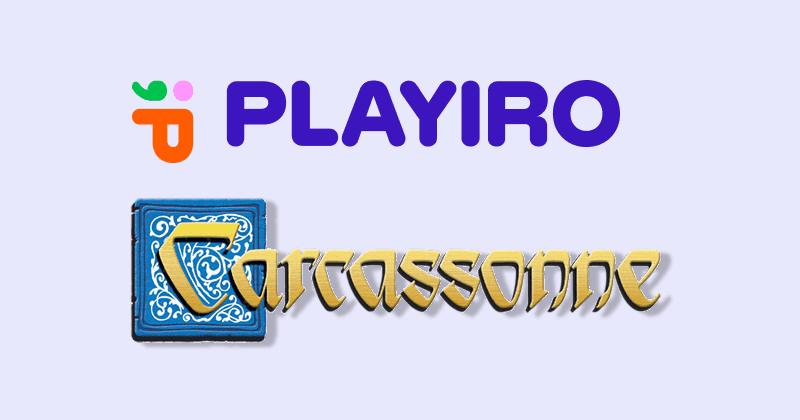
Carcassonne Game Rules
Carcassonne is a tile-laying board game set in medieval France, where players build landscapes of cities, roads, monasteries, and fields. By placing tiles and strategically deploying meeples, players earn points by completing structures.
Created By Adam Davis Fernsby
How to Play Carcassonne Board Game
The board game combines strategy, area control, and a bit of luck, with simple rules that are easy to learn but challenging to master.
Whether you're a beginner or need a refresher, this guide from us at Playiro explains the Carcassonne rules and shares tips to help you win.
Preparations
- Players: 2 to 5 (up to 6 with expansions)
- Game Components:
- 72 land tiles (plus extra tiles for expansions)
- 1 starting tile (marked differently on the back)
- 40 meeples (8 per player)
- 1 *scoreboard
Setup:
- Place the starting tile face-up in the center.
- Shuffle the remaining tiles into face-down stacks.
- Each player takes 8 meeples of their chosen color.
- Place the scoreboard nearby.
Gameplay
Carcassonne is played in clockwise turns.
Each turn consists of three steps:
1. Draw and Place a Tile
- Draw a random tile.
- Place it adjacent to an existing tile.
- Edges must match:
- Roads connect to roads
- Cities connect to cities
- Fields connect to fields
- You must place the tile if it fits legally.
2. Deploy a Meeple (Optional)
After placing a tile, you may place one meeple on your tile. Meeples can go on:
- A city segment
- A road segment
- A monastery
- A field (place lying down)
Important Rule:
You cannot place a meeple on a feature (city/road/field) already occupied by any meeple, even your own.
3. Score Completed Features
If your tile completes a feature, score immediately:
| Feature | Points When Completed | Unfinished at Game End |
|---|---|---|
| Road | 1 point per tile | 1 point per tile |
| City | 2 points per tile + per shield | 1 point per tile/shield |
| Monastery | 9 points if fully surrounded | 1 point per adjacent tile |
After scoring, meeples are returned to the player.
How to Win Carcassonne
The game ends when the last tile is placed.
Final Scoring
- Incomplete features still score reduced points.
- Fields are scored at the end:
- Each completed city touching a field = 3 points.
- Majority control wins → the player with the most farmers in a field earns the points.
- The player with the highest total score wins.
Strategies and Tips
Carcassonne looks simple, but strategic play is essential for victory.
Play with Purpose
- Every tile affects the game board.
- Think beyond fitting tiles → focus on gaining points and blocking opponents.
- Sometimes stopping an opponent is more valuable than completing your own city.
Manage Your Meeples
- You only have 8 meeples.
- Don’t place them all early — you may get stuck without scoring opportunities.
- Sometimes, not placing a meeple is the smartest choice.
Get Meeples Back Quickly
- Early in the game, focus on small, fast-scoring features (short roads, mini-cities).
- This frees up meeples for bigger plays later.
Watch Your Opponents
- Pay attention to where others place meeples.
- If someone builds a large city, you can join it or block it.
Think Ahead
- Consider future moves:
- Will this tile set up a big score later?
- Can it also block opponents?
Field Play (Farmers)
- Fields are scored at game end and can be very rewarding.
- Don’t commit too many farmers early — one well-placed farmer can score huge points.
Don’t Overcommit
- Big cities are tempting but risky.
- Focus on balanced scoring instead of high-risk projects.
Advanced Strategies
- Place farmers early if you want end-game dominance.
- Use tiles to merge cities/roads → gain majority control.
- Save meeples for high-value scoring instead of wasting them on small gains.
- Leave space open where opponents need specific tiles to pressure their plays.
Overview of the Game Rules
| Aspect | Details |
|---|---|
| Goal | Score the most points by placing tiles & meeples |
| Turn Steps | Draw → Place Tile → (Optional) Place Meeple → Score |
| Scoring | Cities = 2 pts/tile, Roads = 1 pt/tile, Monasteries = up to 9 pts, Fields = 3 pts/city at end |
| Win | Player with most points after final scoring wins |
Carcassonne Variants & Expansions
Rules in this game can vary quite a bit.
Carcassonne River Rules
- Uses a river tile set instead of the standard starting tile.
- River tiles are placed first, one by one.
- Adds strategic complexity to the early game.
Carcassonne Farmers Variant
- Fields are an advanced feature.
- Some variants reduce or remove field scoring for faster, simpler games.